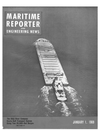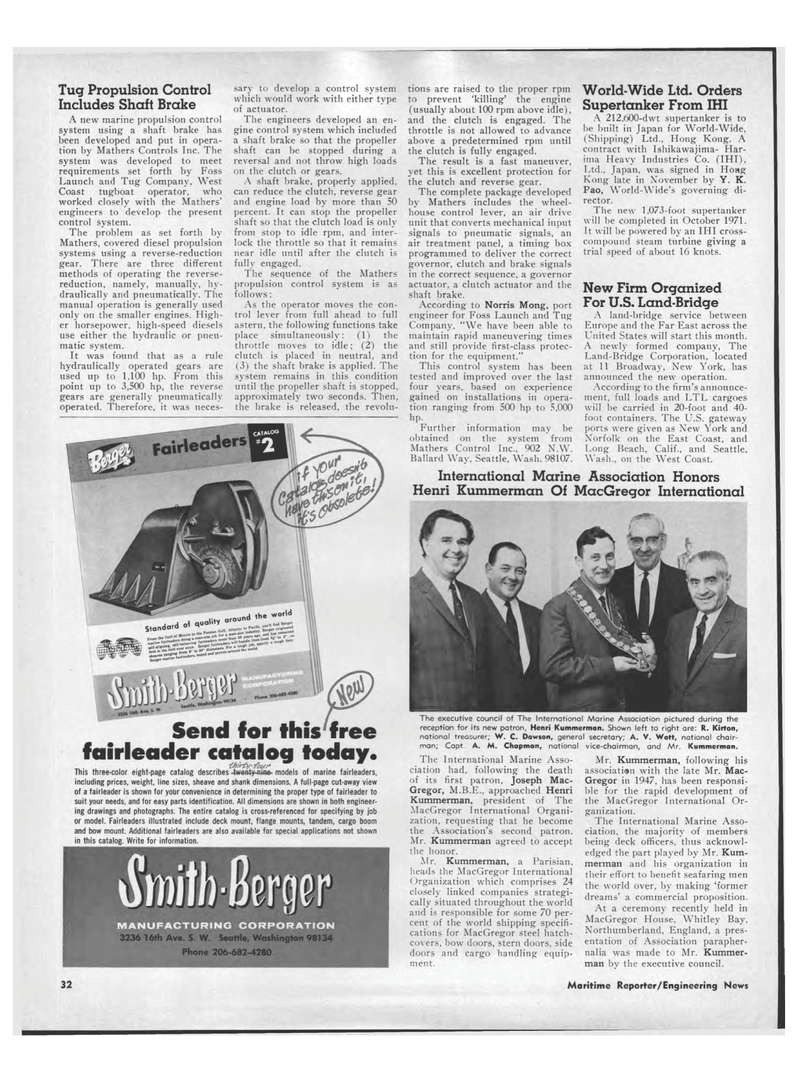
Page 34: of Maritime Reporter Magazine (January 1969)
Read this page in Pdf, Flash or Html5 edition of January 1969 Maritime Reporter Magazine
Tug Propulsion Control Includes Shaft Brake A new marine propulsion control system using a shaft brake has been developed and put in opera-tion by Mathers Controls Inc. The system was developed to meet requirements set forth by Foss Launch and Tug Company, West Coast tugboat operator, who worked closely with the Mathers' engineers to develop the present control system. The problem as set forth by Mathers, covered diesel propulsion systems using a reverse-reduction gear. There are three different methods of operating the reverse-reduction, namely, manually, hy-draulically and pneumatically. The manual operation is generally used only on the smaller engines. High-er horsepower, high-speed diesels use either the hydraulic or pneu-matic system. It was found that as a rule hydraulically operated gears are used up to 1.100 hp. From this point up to 3,500 hp, the reverse gears are generally pneumatically operated. Therefore, it was neces-sary to develop a control system which would work with either type of actuator. The engineers developed an en-gine control system which included a shaft brake so that the propeller shaft can be stopped during a reversal and not throw high loads on the clutch or gears. A shaft brake, properly applied, can reduce the clutch, reverse gear and engine load by more than 50 percent. It can stop the propeller shaft so that the clutch load is only from stop to idle rpm, and inter-lock the throttle so that it remains near idle until after the clutch is fully engaged. The sequence of the Mathers propulsion control system is as follows: As the operator moves the con-trol lever from full ahead to full astern, the following functions take place simultaneously: (1) the throttle moves to idle; (2) the clutch is placed in neutral, and (3) the shaft brake is applied. The system remains in this condition until the propeller shaft is stopped, approximately two seconds. Then, the brake is released, the revolu-Send for this free fairleader catalog today. thirty--four This three-color eight-page catalog describes twanty-nin& models of marine fairleaders, including prices, weight, line sizes, sheave and shank dimensions. A full-page cut-away view of a fairleader is shown for your convenience in determining the proper type of fairleader to suit your needs, and for easy parts identification. All dimensions are shown in both engineer-ing drawings and photographs. The entire catalog is cross-referenced for specifying by job or model. Fairleaders illustrated include deck mount, flange mounts, tandem, cargo boom and bow mount. Additional fairleaders are also available for special applications not shown in this catalog. Write for information. Smith-Merger MANUFACTURING CORPORATION tions are raised to the proper rpm to prevent 'killing' the engine (usually about 100 rpm above idle), and the clutch is engaged. The throttle is not allowed to advance above a predetermined rpm until the clutch is fully engaged. The result is a fast maneuver, yet this is excellent protection for the clutch and reverse gear. The complete package developed by Mathers includes the wheel-house control lever, an air drive unit that converts mechanical input signals to pneumatic signals, an air treatment panel, a timing box programmed to deliver the correct governor, clutch and brake signals in the correct sequence, a governor actuator, a clutch actuator and the shaft brake. According to Norris Mong, port engineer for Foss Launch and Tug Company, "We have been able to maintain rapid maneuvering times and still provide first-class protec-tion for the equipment." This control system has been tested and improved over the last four years, based on experience gained on installations in opera-tion ranging from 500 hp to 5,000 hp. Further information may be obtained on the system from Mathers Control Inc., 902 N.W. Ballard Way, Seattle, Wash. 98107. World-Wide Ltd. Orders Supertanker From IHI A 212.600-dwt supertanker is to be built in Japan for World-Wide, (Shipping) Ltd., Hong Kong. A contract with Ishikawajima- Har-ima Heavy Industries Co. (IHI), Ltd.. Japan, was signed in Hong Kong late in November by Y. K. Pao, World-Wide's governing di-rector. The new 1,073-foot supertanker will be completed in October 1971. It will be powered by an IHI cross-compound steam turbine giving a trial speed of about 16 knots. New Firm Organized For U.S. Land-Bridge A land-bridge service between Europe and the Far East across the United States will start this month. A newly formed company, The Land-Bridge Corporation, located at 11 Broadway, New York, has announced the new operation. According to the firm's announce-ment. full loads and LTL cargoes will be carried in 20-foot and 40-foot containers. The U.S. gateway ports were given as New York and Norfolk on the East Coast, and Long Beach, Calif., and Seattle, Wash., on the West Coast. International Marine Association Honors Henri Kummerman Of MacGregor International The executive council of The International Marine Association pictured during the reception for its new patron, Henri Kummerman. Shown left to right are: R. Kirton, national treasurer; W. C. Dawson, general secretary; A. V. Watt, national chair-man; Capt A. M. Chapman, national vice-chairman, and Mr. Kummerman. The International Marine Asso-ciation had. following the death of its first patron, Joseph Mac-Gregor, M.B.E., approached Henri Kummerman, president of The MacGregor International Organi-zation, requesting that he become the Association's second patron. Mr. Kummerman agreed to accept the honor. Mr. Kummerman, a Parisian, heads the MacGregor International Organization which comprises 24 closely linked companies strategi-cally situated throughout the world and is responsible for some 70 per-cent of the world shipping specifi-cations for MacGregor steel hatch-covers, bow doors, stern doors, side doors and cargo handling equip-ment. Mr. Kummerman, following his associatiun with the late Mr. Mac-Gregor in 1947, has been responsi-ble for the rapid development of the MacGregor International Or-ganization. The International Marine Asso-ciation, the majority of members being deck officers, thus acknowl-edged the part played by Mr. Kum-merman and his organization in their effort to benefit seafaring men the world over, by making 'former dreams' a commercial proposition. At a ceremony recently held in MacGregor House, Whitley Bay, Northumberland, England, a pres-entation of Association parapher-nalia was made to Mr. Kummer-man by the executive council. 36 Maritime Reporter/Engineering News

 33
33

 35
35
